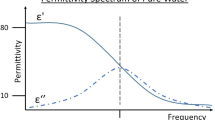Abstract
This paper reports research into the application of Ground Penetrating Radar (GPR) technology to the physical characterization of concrete and gives the details and results of an experimental study on the effect of concrete moisture on radar waves propagating through concrete laboratory slabs. Radar measurements were performed using a commercial radar system with 1.5 GHz ground-coupled antennas. The concrete slabs were conditioned so as to possess different degrees of saturation and a homogeneous moisture distribution. Electrical resistivity measurements were also carried out on each concrete sample to provide complementary information regarding the moisture content of the concrete. Interesting results were found concerning the ability of the radar technique to characterize the moisture state of concrete. Attention was especially focused on the amplitude, velocity and frequency spectrum of the waveforms recorded. In particular, the behavior of the transmitter-receiver direct wave was found to be greatly influenced by the moisture in the concrete. Finally, some experimental results were simulated using a simple dielectric model of heterogeneous mixtures.
Résumé
Les travaux de recherche relatés dans cet article portent sur l'application de la technologie géoradar (GPR) à la caractérisation physique du béton. Les auteurs présentent les détails et les résultats d'une étude expérimentale sur l'effet de l'état d'humidité sur les ondes radar se propageant dans le béton. Les mesures radar sont réalisées au moyen d'un système GPR commercial utilisant des antennes couplées de fréquence centrale égale à 1.5 GHz. Des dalles en béton ont été conditionnées de manière à obtenir différents degrés de saturation et à répartir l'humidité de façon homogène. De plus, des mesures de résistivité électrique ont été réalisées à titre d'information complémentaire sur l'état d'humidité du béton. Des résultats intéressants ont été obtenus concernant l'aptitude de la technologie radar à la caractérisation hydrique des bétons. Dans cet article, l'accent est mis sur l'amplitude, la vitesse et le contenu fréquentiel des formes d'ondes enregistrées en laboratoire. Parmi les différents résultats obtenus, le comportement de l'onde directe émetteur-récepteur s'est révélé particulièrement influencé par l'état d'humidité du béton. Enfin, certains comportements observés en laboratoire ont pu être simulés sur la base d'un modèle simple de mélange diélectrique.
Similar content being viewed by others
References
Maierhofer, C. and Wöstmann, J., ‘Investigation of dielectric properties of brick materials as a function of moisture and salt content using a microwave impulse technique at very high frequencies’,NDT & E International 31 (4) (1998) 259–263.
Binda, L., Lenzi, G. and Saisi, A., ‘NDE of masonry structures: use of radar tests for the characterisation of stone masonary’,NDT&E International 31 (6) (1998) 411–419.
Garciaz, J.L. et Perrin, J.L., ‘Application du radar géophysique pour l'évaluation des variations de permittivité et de résistivité des matériaux de surface—Conception d'une antenne spécifique et traitement de données’, Journées scientifiques ENDGC 2, Bordeaux (Novembre 2001).
Soutsos, M.N., Bungey, J.H., Millard, S.G., Shaw, M.R. and Patterson, A., ‘Dielectric properties of concrete and their influence on radar testing’,NDT & E International 34 (2001) 419–425.
Robert, A., ‘Dielectric permittivity of concrete between 50 MHz and 1 GHz and GPR measurements for building materials evaluation’,Journal of Applied Geophysics 40 (1998) 89–94.
Rhim, H.C. and Büyüköztürk, O., ‘Electromagnetic properties of concrete at microwave frequency range’,ACI Material Journal 95 (3) (1998) 262–271.
Debye, P., ‘Polar Molecules’ (Chemical Catalogue Company, 1929).
Laurens, S., ‘Aptitude de la technique à la caractérisation du béton d'enrobage—Aide au diagnostic de la corrosion des armatures’, Doctoral thesis, INSA Toulouse & Université de Sherbrooke (2001).
AFPC-AFREM, ‘Détermination de la masse volumique apparente et de la porosité accessible à l'eau, Mode opératoire recommandé’, Compte-rendu des Journées Techniques (Toulouse, 11–12 December 1997) 121–124.
Whittington, H.W., ‘The conduction of electricity through concrete’,Magazine of Concrete Research 33 (114) (1981).
Lopez, W. and Gonzalez, J.A., ‘Influence of the degree of pore saturation on the resistivity of concrete and the corrosion rate of steel reinforcement’,Cement and Concrete Research 23 (2) (1993) 368–376.
Padaratz, I.J. and Forde, M.C., ‘A theoretical, evaluation of impulse radar wave propagation through concrete’,Journal of Non-destructive testing & Evaluation 12 (1995) 9–32.
Halabe, U.B., Sotoodehnia, A., Maser, K.R. and Kausel, E.A., ‘Modeling the electromagnetic properties of concrete’,ACI Materials Journal 90 (6) (1993) 552–563.
Author information
Authors and Affiliations
Additional information
Editorial note LMDC (France) is a RILEM Titular Member. Prof. Ginette Arliguie is a RILEM Senior Member. Mr. Jean-Paul Balayssac participates in RILEM TCs 189-NEC ‘Non-destructive evaluation of the ‘covercrete’ (concrete cover)’ and INR ‘Interpretation of NDT results and assessment of RC structures’.
Rights and permissions
About this article
Cite this article
Laurens, S., Balayssac, J.P., Rhazi, J. et al. Non-destructive evaluation of concrete moisture by GPR: Experimental study and direct modeling. Mat. Struct. 38, 827–832 (2005). https://doi.org/10.1007/BF02481655
Received:
Accepted:
Issue Date:
DOI: https://doi.org/10.1007/BF02481655




